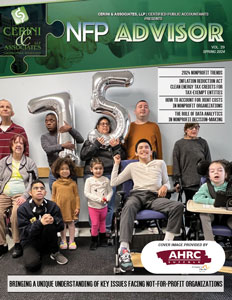As we move deeper into 2024, we look at what we can expect for the nonprofit sector as the year progresses. In 2023, the sector grappled with multiple challenges… the end of the COVID era which meant an end of COVID funding, an increase in demand for services brought about by several years of high inflation, a tight labor market, continued increases in borrowing rates, the exponential growth of AI and cybercrimes, and an increase in regulations and government audits. 2023 did see an uptick in the stock market bringing with it an increase in donations, and an economy that was better than anticipated…
The headlines for 2024 will focus around some of the same themes… the economy, technology, and the labor market.
THE ECONOMY:
- We anticipate a slow down in inflation, with inflation sitting between 2 and 3% for the year.
- We also anticipate a slow down in growth, we growth at only 1.5% to 2% as high interest rates, geopolitical concerns (war in Ukraine, unrest in the Gaza, and the biggest election year in history with more than 60 countries holding regional, legislative, and presidential elections), and what is anticipated to be a hotly contested presidential election, all create uneasiness in the marketplace.
- We expect growth in unemployment from the 3.7% we saw at the end of 2023 to 4.4% as the rise in AI, the cost of capital, and overall uncertainty in the marketplace take their toll on the workforce.
- While we expect to see some pull-back on interest rates, we are not expecting to see them until the second half of the year, and they are not going to be deep … so don’t look for pre-pandemic rates anytime soon. Expect banks to be more conservative with lending, restricting credit to lower quality lenders and requiring higher levels of collateral.
- The stock market is anticipated to see a rise, with an industry expectation of 10% for the S&P 500.
SO WHAT DOES THIS MEAN FOR THE NONPROFIT SECTOR?
- NYC is anticipating budget shortfalls over the next 3 years of 6%, 8%, and 9%, respectively, while NY State is anticipated to have a $4.3 billion budget shortfall for fiscal 2025. Both NY City and NY State will need to balance these shortfalls, and that will most likely come in the form of cuts. You will need to consider this when developing budgets and strategizing your operations for the next year. We will have a clearer picture when the NY State budget is released in April. NY City has already made two cuts (one in December and another in January). It appears for now, that a third cut that was supposed to happen in April 2024 has been cancelled. Even so, contract signing and cash flow at the local level (counties and NY City) have been heavily delayed.
- The loosening of the labor market should result in the ability to finally hire much needed staff, however organizations need to be cautious to see how their funding shapes up. Unfortunately, the loosening of the labor market could also result in an increased demand for services.
- Fundraising tends to follow the stock market. With an anticipated bull market for 2024, we anticipate an uptick in donations during 2024. Unfortunately, with the polarized position on policies and issues during this year’s election (immigration, climate change, abortion, education/cultural wars, and crime) coupled with geopolitical issues, while donations may be up, they may not necessarily find their way to local charities.
- Nonprofits will need to be more creative and targeted in their approach to fundraising.
- Nonprofits need to be strategic in their thought process and re-assess their mission, their relevancy, their business models, etc. Everything should be on the table and open for discussion.
TECHNOLOGY:
- AI continues to be the fastest growing sector in the marketplace. It is causing us to rethink the way we operate, deliver service, fundraise, and more. While 89% of nonprofits agree that AI will improve efficiency, only 28% say they use it in any meaningful way. A Goldman Sachs study said that AI tools could impact more than 300 million full-time jobs worldwide.
- Cybercrimes are up… through the first half of January 2024, there was a cyber-attack every 39 seconds.
- With the need for nonprofits to be more streamlined and nimble due to constricted funding, we are seeing an increase in data integration and workflow automation.
SO HOW DOES THIS IMPACT THE NONPROFIT SECTOR?
- The sector needs to embrace AI as a tool in all aspects of their operations.
- In fundraising, AI can be used to identify potential donors, create personalized marketing and social media campaigns and content, make next step recommendations, donor journey mapping and more.
- From an operations perspective, AI can be used for business simulations to optimize your operations from a staffing, resource allocation, and performance perspective.
- AI can automate simple tasks such as summarizing meeting notes, organizing and cleaning data, crating documents and policies, developing reusable templates and outlines. Organizing files, and more.
- It is anticipated that by 2030, 30% of work hours across the US economy could be automated with AI and 50% of nonprofit activities (not jobs) can be automated using AI, leading to more efficient and productive organizations.
- There is an increase in cyber-attacks within the nonprofit sector, as historically the sector has been behind the technology curve. Nonprofits need to implement stronger policies (for example AI usage policy), increased internal training, regular updates, and vigilance. This will require a greater investment by the sector.
- Nonprofits need to find ways to better automate systems so that all systems are effectively communicating. This will save time, decrease errors, and provide for more timely information. This is essential, as nonprofits will need to make decisions quicker and will need information flow to make that happen.
THE LABOR MARKET:
- Although we anticipate a softening of the labor market with increased lay-offs (according to a survey by ResumeBuilders, 40% of companies are considering layoffs by 2024), nonprofits will still need to reconsider their salaries, benefit packages, and leadership culture in order to attract and retain staff.
- In PNP Staffing’s 2024 annual nonprofit salary study, 91% of nonprofits reported having to increase salaries in 2024 and 35% reported that they could not meet the expected salary demands for top talent and common staff positions.
- The nonprofit turnover rate (19%) is 58.3% higher than for other companies (12%).
WHAT SHOULD NONPROFITS DO?
- Nonprofits need to retool their leadership to align with their workforce. Leaders need to be better trainers, more empathetic, more transparent, provide more timely and relevant feedback, and offer greater level of accessibility.
- Nonprofits need to work with their staff on career development and growth, laying out paths for advancement for staff members. Among workers who left nonprofit jobs during 2021, 44% said they left because nonprofits didn’t offer enough opportunities for career growth or professional development and 38% of young nonprofit professionals think they will need to move organizations to get a promotion.
- Nonprofits need to benchmark their salaries and benefits to determine how they compare to not just industry standards but also those of industries that would look for staff with similar skillsets. This incudes providing staff with work flexibility, a greater work life balance, a healthy workplace, and more.
2024 needs to be the year that nonprofits think strategically about their business and operations. There are about 3,500 nonprofits on Long Island and about 35,000 in the NY City metropolitan area.
Are they all necessary?
What are they doing by way of
collaboration and consolidation?
Is their proper oversight and leadership?
How are they addressing DEIA
at all levels of the organization?
Are they impactful?
How can they become more efficient and effective?

THIS ARTICLE WAS ALSO FEATURED IN NFP ADVISOR VOL. 29. READ THE ARTICLE AND MUCH MORE RELATED CONTENT HERE!

Kenneth R. Cerini, CPA, CFP, FABFA
Managing Partner
Ken is the Managing Partner of Cerini & Associates, LLP and is the executive responsible for the administration of our not-for-profit and educational provider practice groups. In addition to his extensive audit experience, Ken has been directly involved in providing consulting services for nonprofits and educational facilities of all sizes throughout New York State in such areas as cost reporting, financial analysis, Medicaid compliance, government audit representation, rate maximization, board training, budgeting and forecasting, and more.





No comment yet, add your voice below!